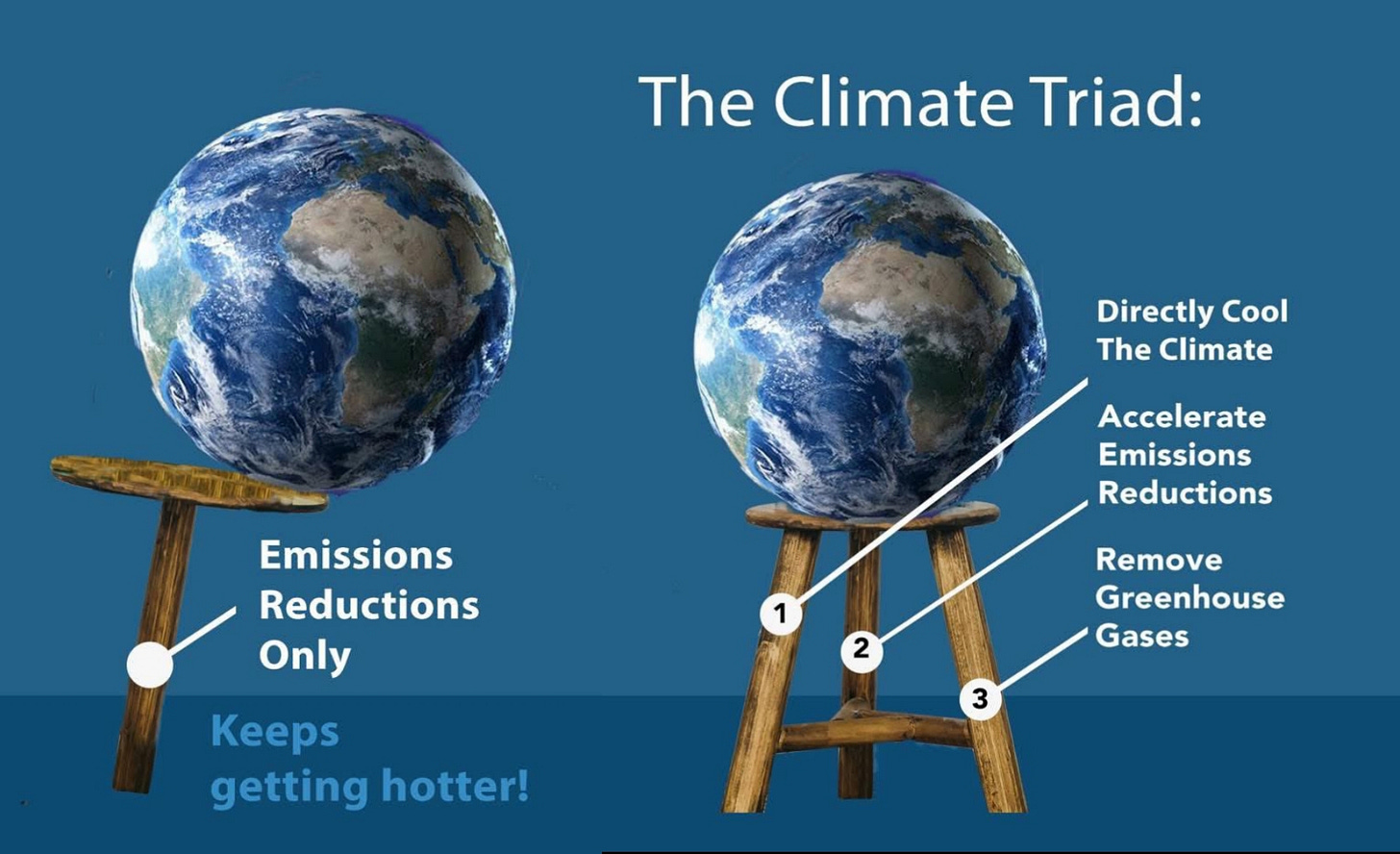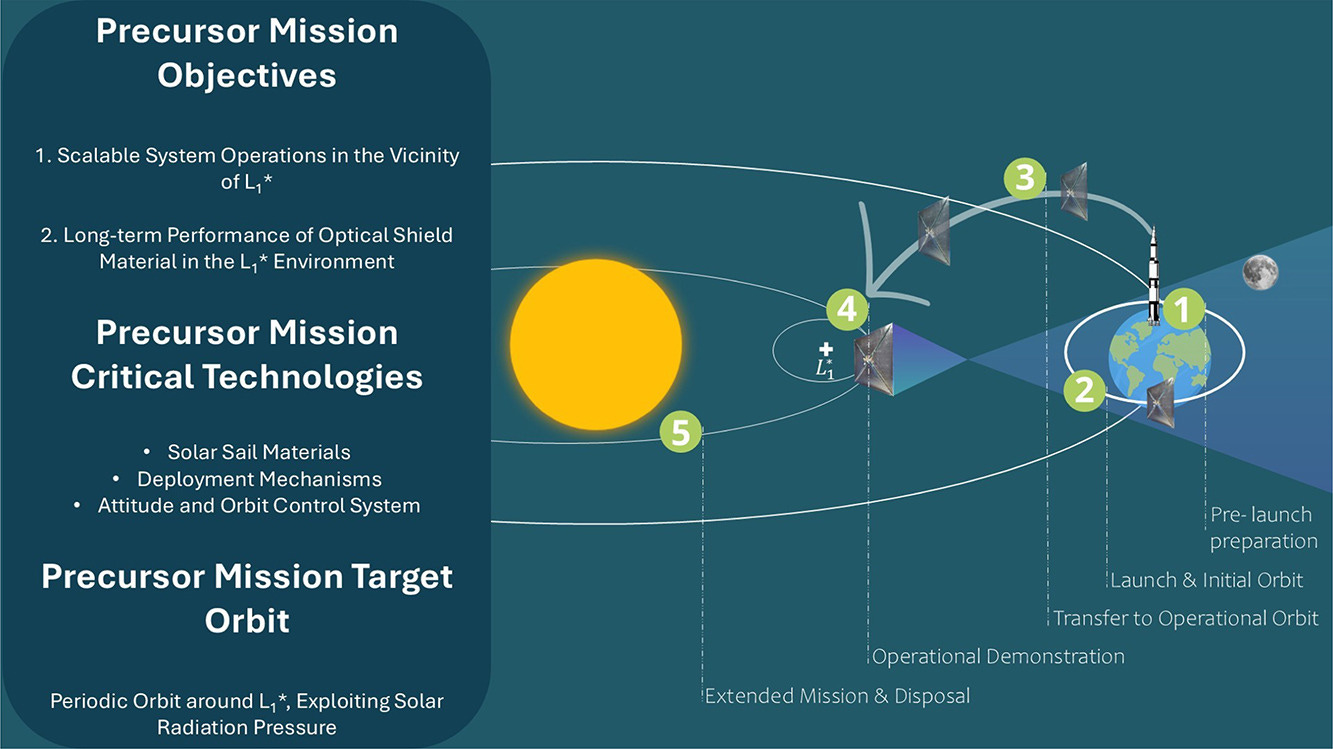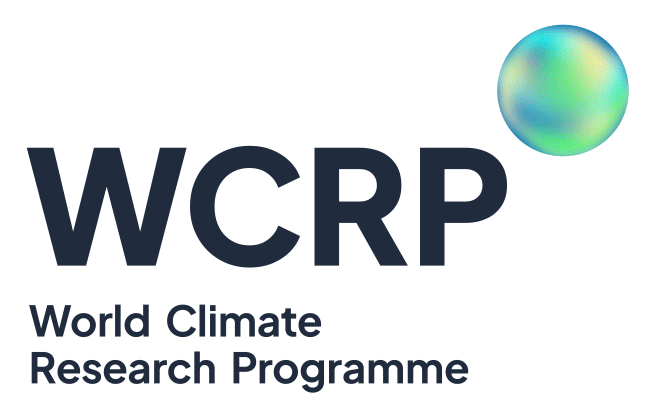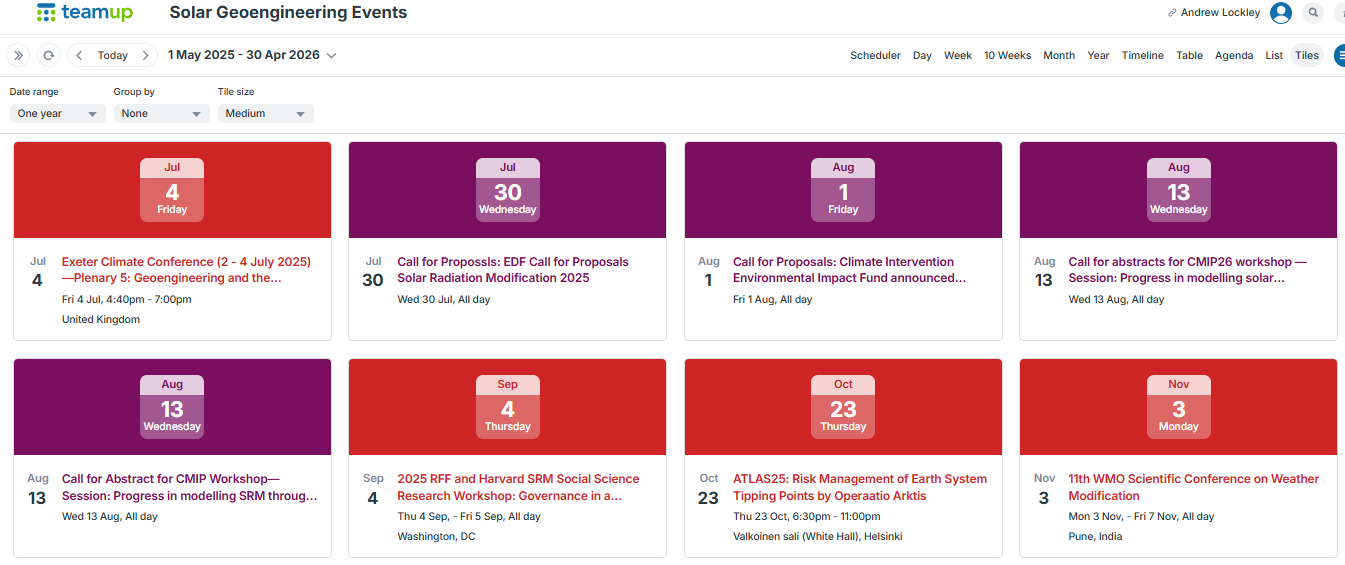Monthly Solar Geoengineering Updates (June'2025)
June at a glance: New SRM studies, outdoor experiments, state bans, security concerns, and growing global debates over when, where, and how to act.
Everything we publish on Solar Geoengineering Updates is free to access. If you value this work and are able, please consider supporting us as a paid subscriber. Your support sustains this vital work and helps us reach more people with balanced, timely information on this critical topic.
TOP 10 SRM HIGHLIGHTS FROM JUNE’25
CSEi FUNDED PROJECTS: The Climate Systems Engineering initiative (CSEi) has awarded over $7 million to 14+ interdisciplinary projects advancing climate systems engineering research and policy. Topics include SRM, CDR, glacial interventions, and governance and public perception.
HIGHER INJECTION IMPROVES SAI: New study (preprint) finds injecting sulfur aerosols at 50 km instead of traditional 25 km cuts side effects, boosts cooling, helps ozone recovery & preserves more Arctic ice. However, the caveat is that planes can’t reach 50 km, so researchers propose reusable hydrogen rockets to deliver 3–8 Tg SO₂/yr using 30–80 rockets flying every other day.
PROPOSED PLANETARY SUNSHADE MISSION: Another paper proposes the preliminary design of a $10M precursor mission for a Planetary Sunshade System at the photo-gravitational point. A 12U CubeSat with a 400 m² solar sail would test shielding, solar sailing, and autonomous control for future solar geoengineering.
AEROSOL DECLINES UNMASK HIDDEN WARMING: A recent Carbon Brief article by Zeke Hausfather explains how human-made aerosols affect the climate and how emissions have changed over time. These aerosols have hidden about 0.5°C of warming by reflecting sunlight and brightening clouds. Since SO₂ fell by around 40% since the mid-2000s, about 0.14°C of warming, or 25% of recent warming (0.5°C), has now been unmasked as this cooling effect fades.
SRM MORATORIA: Sue Biniaz and Daniel Bodansky argue in a new piece that a global moratorium on solar radiation management could block vital research, be hard to enforce, and unintentionally become a proxy for a permanent ban. Bodansky expanded on this in the Reviewer 2 Does Geoengineering podcast, calling instead for more research and stronger governance frameworks to better understand and responsibly manage geoengineering.
OUTDOOR EXPERIMENTS TRACKER: SRM360 has launched an SRM Outdoor Experiments Tracker that lists completed, ongoing, upcoming, and cancelled outdoor experiments related to solar geoengineering. These experiments test equipment, release materials, or modify clouds to advance SRM research, improve deployment capabilities, or enable SRM deployment.
GEOENGINEERING BANS CONTINUE: Two more US states, Florida and Louisiana, have passed laws banning geoengineering and weather modification in their skies, following Tennessee. Florida’s law makes violations a third-degree felony, with penalties of up to five years in prison and fines up to $100,000. However, Louisiana State Representative Kimberly Landry Coates argues their state has banned a nonexistent problem.
UK PROBES GEOENGINEERING SECURITY CONCERNS: UK ministers are preparing for a dire scenario in which hostile powers could weaponise solar geoengineering for geopolitical gain. A leaked letter reveals concerns about rogue actors using SRM unilaterally, risking climate disruption, crop damage, and enforcement challenges, or even ‘orchestrating environmental disaster’ for their enemies.
GEOENGINEERING DEBATE HELD IN UK PARLIAMENT: UK Parliament debated geoengineering after a public petition. Dr. Roz Savage, a Liberal Democrat MP, raised SRM concerns, while MP Kerry McCarthy clarified the government’s stance, saying the UK has no plans to deploy SRM but supports research on risks and impacts if others act. A background paper and full debate transcript with speakers are available.
UPCOMING EVENT: The WCRP Lighthouse Activity “Research on Climate Intervention” and the Core Activity “Atmospheric Processes and their Role in Climate” will host a series of virtual workshops on Stratospheric Aerosol Injection from 6–9 October. Submit an abstract or register by 15 August 2025 to present or join discussions.
For a full recap of last month’s updates, check out our weekly summaries: WEEK 1 | WEEK 2 | WEEK 3 | WEEK 4
And here’s a quick short overview:
RESEARCH PAPERS, THESES AND PROJECTS
From power grids and farms to clouds and politics, studies from the past month showed that solar geoengineering may bring benefits and risks that vary greatly by region.
Energy & Local Climate
How tweaking sunlight could reshape energy and water in different regions?
Caribbean: Blocking some sunlight might slightly reduce solar power (by 1–3%) but could significantly boost wind energy, with up to 90% more output for taller turbines. Important context for island energy planning. (Williams et al.)
Southeast Asia: Extreme rainfall may increase in parts of Indonesia, while Vietnam and the Philippines could see longer dry spells. Flood and drought risks shift in complex ways. (Kuswanto et al.)
Africa: Temperatures drop under SRM, but rainfall changes are uneven, potentially helping northern farms while challenging water security in Central and East Africa. (Egbebiyi et al.)
Clouds, Aerosols & Climate Feedbacks
How could geoengineering using aerosols and cloud brightening shape climate feedbacks, warming, and rainfall?
Absorptive aerosols: High-altitude, heat-absorbing aerosol particles under SAI could weaken the CO₂ greenhouse effect more efficiently than traditional scattering particles, though this remains theoretical. (He et al.)
Atmospheric rivers: Stratospheric aerosols may reduce extreme inland floods but change where ocean storms deliver rain. Some regions benefit, others lose out. (Quagraine et al.)
Long-term pathways: Without geoengineering, feedback loops could drive up to 75% of warming by 2100. Mild annual interventions might help buy time. (Feinberg)
Cloud brightening trade-offs: Brightening ocean clouds could boost soil moisture and crops, but doing it over land risks drying soils and cutting carbon storage. (Fang & Cao)
Experiments, Models & Politics
Who drives geoengineering experiments, where models fall short, and how public opinion could shift?
Innovation trends: 20 pilot geoengineering projects reveal how coalitions, funding, and expectations are shaping climate intervention work. (Sovacool et al.)
Field trials: Clear tests for rigor, safety, usefulness, and transparency are vital before doing small-scale experiments. (O’Loughlin & Visioni)
Model gaps: Key physics and cloud processes are still missing in today’s models, better data is urgently needed. (Eastham et al.)
Public opinion: Knowing more about solar geoengineering could help bridge the partisan divide on climate action in the US. (Magistro et al.)
Theses & Projects
Where could safer materials, integrated approaches, and real-world testing take climate engineering next?
Bio-based aerosols: Cellulose nanocrystals may offer a renewable, less harmful option for stratospheric aerosol injection. More modelling is needed. (Warnes)
Integrated approaches: Geoengineering should complement, not replace, emissions cuts. Fresh analysis covers SAI, sponge cities, rock weathering, and biochar. (Khasgiwala)
Real-world testing: Marine cloud brightening studies are moving beyond theory to assess how it behaves under complex, changing conditions. (Harrison & Team)
PODCASTS AND VIDEOS
Recent podcasts and videos take a closer look at how solar geoengineering research is evolving, alongside legal debates and global conversations on risks, trust, and public engagement.
The UK’s new sunlight reflection trials discussed on Climate Reflections, Nick Breeze ClimateGenn, and Nine to Noon, while legal and human rights debates are unpacked in A Climate Justice Podcast.
Remove and Reflect Podcast unpacks bold new ideas like high-altitude sulfur injections, using aerosols to weaken the greenhouse effect, and why human behaviour and trust could make or break any future deployment.
Voices from Operaatio Arktis and The Transition Accelerator call for more public and youth engagement, while The Aspen Institute and Climate Conversations tackle the big question: should we really dim the sun?
Meanwhile, NSF NCAR shares lessons from volcanic eruptions to understand how stratospheric injections might affect our climate, while Solar Climate Intervention Talks and Healthy Planet Action Coalition raise security and geopolitical concerns of SAI.
The 2025 Degrees Global Forum, held in Cape Town from 12–16 May, was the largest conference to date focused on solar radiation management. Watch all session recordings in The Degrees Initiative playlist.
UPCOMING EVENTS AND DEADLINES
Big conversations are happening in the second half of this year for anyone watching solar geoengineering.
The Exeter Climate Conference closes out on 4 July with a spotlight on responsible climate intervention. In September, RFF and Harvard will gather experts in Washington DC to tackle SRM governance in a fractured world. October brings a virtual deep dive into Stratospheric Aerosol Injection (6–9 Oct) by WCRP and a risk management event organized by Operaatio Arktis in Helsinki (23 Oct).
Then AGU 2025 kicks off in New Orleans just before the holidays (15–19 Dec). Early next year, CMIP26 lands in Kyoto (9–13 March). If you’re presenting, keep those submission deadlines in sight: AGU abstracts close 30 July, CMIP SRM papers are due 13 August, and WCRP’s virtual SAI workshop wraps submissions by 15 August.
All these events, deadlines, and more are listed in the Solar Geoengineering Events Calendar by Andrew Lockley, the go-to hub for tracking SRM activities worldwide.
Subscribe to the Solar Geoengineering Events Calendar by adding this link to your default calendar: https://ics.teamup.com/feed/ks64mmvtit583eitxx/0.ics
Follow us on:
Twitter | Bluesky | YouTube | Substack | Google Group | Podcast 1 | Podcast 2
Support us here:
While all content on Solar Geoengineering Updates is free for everyone, We urge those who can to become paid subscribers. Your support empowers this important work and helps us spread the message far and wide.
















